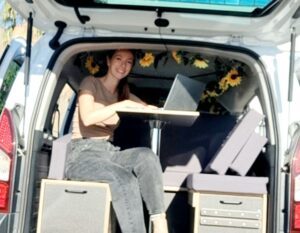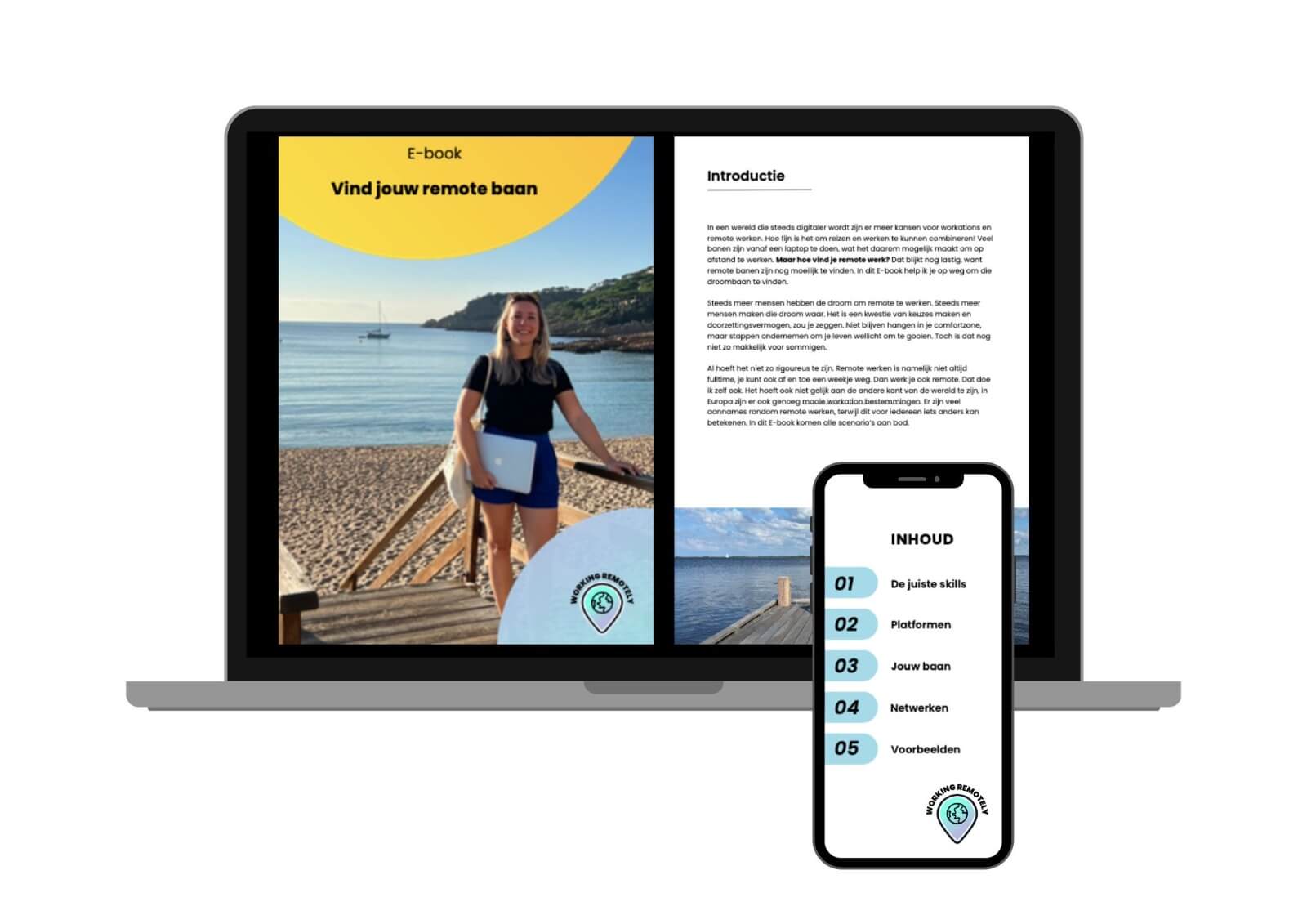Stephanie Maatman is a Virtual Assistant (VA), helping entrepreneurs with support tasks in their businesses. She has been living in Spain for 9 years, but will soon start traveling far away again. After all, as a VA with your own business, you can work completely online and work wherever you want. In this blog, she shares her experiences and tips on how you too can start as a VA and create a successful location-independent job.
The beginning: a call center job in Spain
Nine years ago, I moved to Spain with one goal: to learn Spanish. I enrolled in a language school and soon found a job in a call center. Not exactly my dream job, but I told myself it was temporary and that I would have a better job in a few months. But four years later I was still there, exhausted and with zero energy to look for another job. Not that it mattered much, because nice and well-paying jobs are virtually impossible to find in Spain.
Then came Covid. From one day to the next we had to work from home. I heard gossip all around me that we were going to be cut and secretly hoped for that enormously. I couldn’t take it anymore, but didn’t have the guts to resign myself. After 6 months of uncertainty came the redeeming word: 30% of customer service was being cut, but only in the “expensive offices” in the Netherlands, England and Germany. As employees in Spain, we earned significantly less than our Dutch colleagues so we were allowed to stay. But I knew I couldn’t go on. If I wasn’t going to be cut out, I had to do it myself. That same day I voluntarily resigned.

My start as a Virtual Assistant
There I was: in Spain, without a job. Jobs were scarce and everything that seemed “remote” didn’t really turn out to be so (think: having coffee together in the office once a week “for team spirit”). Until I spoke to a coach who said, “Why don’t you become a VA?” I had never heard of it before, but became curious. After a few short courses, I decided to just give it a try.
My first job earned me 10 euros, for an hour’s worth of work. Not enough to live on, but enough to gain experience and get my first positive reviews. A few months later, I found my first regular client through a Facebook group. It clicked right away, and through her recommendations, more clients soon followed. Three months after I quit, I was earning more as a VA than I was in the call center.
How to build your career as a VA
After working for almost a year as a Customer Service VA (answering emails for clients), I decided to specialize as a Technical VA (building websites and online systems, among other things). In my second year as a Technical VA, I raised my rate to 60 euros per hour and was able to work less. I was approached more and more often by Dutch people who wanted to know how they could also work as a VA in Spain and started giving (free) advice.
In year 3, free consulting began to get out of hand. I was spending more than 10 hours a week helping other new VAs. I decided to pour my knowledge into a course to help more people. By now I have been doing this profession for 5 years and now I combine mentoring (starting) VAs with my work as a Technical VA. I enjoy doing both and the combination gives me a lot of variety in my work.


What does a Virtual Assistant actually do for tasks?
A VA supports small businesses on a freelance basis with tasks that can be done online. As a VA, you almost always work 100% remotely, so you choose where you work. The tasks vary from VA to VA, but these are 10 common tasks:
● Answering emails
● Calendar management and scheduling appointments
● Scheduling and managing social media posts
● Sending newsletters
● Making reservations for clients
● Invoicing and administration
● Taking minutes
● Maintaining client records
● Putting together flyers / e-books
● Setting up websites and online systems
You choose what tasks you offer or don’t offer. You can keep it simple by only offering customer service via e-mail (you don’t need experience for this), or you can grow into something more challenging, such as building and maintaining websites.
The key skills of a VA
Are you also considering starting out as a VA, but wondering if you are qualified? Don’t worry, I’ve never met a VA who didn’t have doubts about this in the beginning!
Self-direction is the most important skill for a Virtual Assistant. As a VA, you don’t have a boss. That sounds wonderful (and it is!), but you have to have the discipline and perseverance to take action yourself. You get to make all the choices yourself (yes, freedom), but in return, you have to be responsible. If you don’t take action, nothing will happen.
Next to self-direction, these are the most important skills for a VA:
● Reliability: make sure you keep appointments
● Communication: be clear and professional with your customers
● Curiosity: keep developing yourself so that your VA business can grow
● Time management: make your own schedule and pay close attention to your work/life balance
● Initiative: a really good VA always looks at what else can be done or improved
How much experience do you need to get started?
I often talk to people who are held back by the idea that they have no experience. But while working as a VA may be new to them, they already have experience with many things from employment. Things like: sending emails, speaking to clients and scheduling appointments many people have already done from employment. Working as a VA is not that insanely different. You take away more experience from previous jobs than you might think now.
How do you find clients as a VA?
As a VA starting out, you find clients primarily through freelancer platforms and Facebook groups for entrepreneurs. For the participants of my course “How to become a VA” I made a list of the concrete places where I see a lot of calls from entrepreneurs looking for VAs. With the code workingremotely you get 20% off the price. After registering you can get started right away!
Another thing I hope you noticed in my story is that my first ongoing client brought in new clients immediately, thanks to her recommendations. And that “network effect” is growing. I have not been actively seeking clients myself for over 2 years. My network is now so big that people know how to find me and I no longer have to look for them myself. So it is certainly not the case that as a VA you have to chase new collaborations day in and day out for years. Once the “client ball is rolling” and you have built a good name for yourself, finding new clients becomes a whole lot simpler.
VA combined with other work
A big advantage of working as a Virtual Assistant is that it is incredibly flexible. A full-time VA usually has 5 – 8 ongoing clients. So if you want to work part-time, you just take on fewer clients very simply. Many VAs build their business gradually, in addition to their salaried job. They start with 1 or 2 hours a week and grow that way. That immediately makes starting as a VA a lot less exciting.

The freedom of working online
The best thing I’ve gotten out of the VA profession is the freedom to arrange my work and my time the way I want. It is still just work (don’t be fooled by internet gurus who claim that working 4 hours a week will earn you 10,000 euros a month), but it is work on your own terms.
It’s mostly the little things that give the feeling of freedom.
I’m not going to become a millionaire from my VA work, but it does give me the freedom to work from abroad. Or to give myself a Tuesday off so I don’t have to trudge through a packed IKEA on Saturday. Or to start a few hours later because I had a late dinner the night before, without having to ask permission from a boss.
Do you also want to get started as a VA?
Are you sitting reading this and thinking, like me 5 years ago “This is exactly what I’m looking for, but where do I start?”. Then you are most welcome to join the online course So Become A VA. In the course I take you step by step through how to start as a VA, find clients and build your own business. Without vagueness and without empty promises, but with practical steps that really work. With the code workingremotely you get 20% off the price and save €160 instantly! After signing up, you can get started right away and have your own VA business set up in no time!
More inspiration about people working online
beroepsavonturier reist al 9 jaar als digital nomad door Europa









